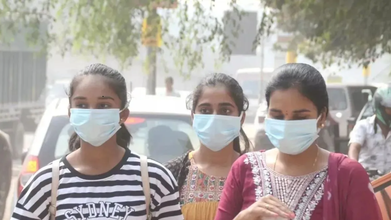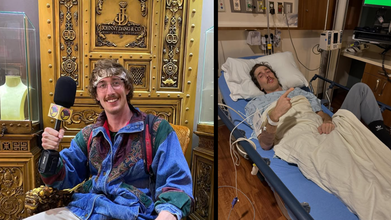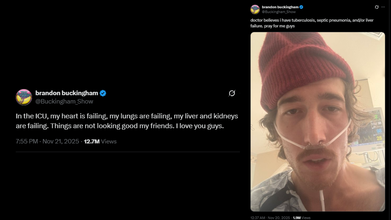- Health Conditions A-Z
- Health & Wellness
- Nutrition
- Fitness
- Health News
- Ayurveda
- Videos
- Medicine A-Z
- Parenting
Popular 'Safe' Toothpaste Brands Contain Heavy Metals, Finds Study

Credits: Canva
In other news, another study has raised concerns about the safety of what people consume on a daily basis. Amid all the things that we know of, which consists heavy metals, your regular used toothpaste is also now on the list. As per the consumer advocacy group Lead Safe Mama, a large number of popular toothpaste products contain heavy metals. These are lead, arsenic, mercury, and cadmium. The study also found that those marketed as safe for children too contain these metals.
How Was The Research Conducted?
The organization tested 51 different toothpaste brands. The results then revealed that 90% of these samples were contaminated with lead. Of them, 65% contained arsenic, and nearly half had mercury, while one-third tested positive for cadmium. The Guardian was the first one to report these findings.
What Inspired This Research?
Tamara Rubin, who is the founder of Lead Safe Mama, has been investigating heavy metal contamination for over a decade now. Her interest began when she saw families whose children had alarmingly high levels of metals in their blood. Her past observations have also already highlighted the content of Earthpaste, which had raised concerns.
She said that these recent findings were "unconscionable - especially in 2025". She also criticised the companies which were involved for failing to take responsibility or initiate corrective measures. “None of the companies dragged after the outcome admitted to working towards eliminating lead from their toothpastes,” she said. Instead, some brands reportedly issued cease-and-desist letters in response to Rubin’s findings, which she publicly addressed on her blog, tamararubin.com.
Which Popular Brands Are On The Red Flag List?
The report noted for some of the top-selling toothpaste brands in the US, including the ones which are marketed as safe for children. The brand names are:
- Crest
- Sensodyne
- Colgate
- Tom’s of Maine
- Dr Bronner’s
- Davids
- Dr Jen
- Dr Brite
What Ingredients Do These Toothpastes Contain?
Rubin’s research suggests that certain ingredients are consistently linked to higher levels of heavy metal contamination. Specifically, hydroxyapatite, calcium carbonate, and bentonite clay were found to be contributing factors.
Bentonite clay, often included for its cleaning properties, showed the highest levels of contamination. Hydroxyapatite, known for aiding calcium absorption, and calcium carbonate, commonly used for stain removal, were also found to contain troubling amounts of lead and other metals. Toothpastes that did not include these ingredients—such as Dr Brown’s Baby Toothpaste—were free of contamination, according to the findings.
What Has Been The Brands' Response?
The companies who have been red listed have responded, however, all in different ways. While some offered explanations, others have downplayed the findings. Dr Jen's for instance shared a graph with Lead Safe Mama which showed their toothpaste's metal concentration was well below the US Food and Drug Administration's safety thresholds.
However, Rubin challenged this defence, arguing that the FDA’s limits are outdated and not aligned with the current scientific consensus. “All federal agencies agree that there is no safe level of lead exposure for human beings, especially children,” she stated. In a pointed rebuttal, Rubin added, “I expected more from you. I assumed your product would not have harmful toxicants that could impact my children.”
She also criticised Dr Jen’s for using safety standards intended for fluoride toothpaste, noting that the tested product was non-fluoride, for which safety limits are even stricter—and still too high in her view.
What Do Experts Say?
The US Centers for Disease Control and Prevention (CDC) maintains that no level of lead exposure is considered safe. However, the loophole is that while the reports may have found lead levels which do not exceed the federal limits, but they do surpass state limits in Washington and California, and many more like them.
California’s legal lead limit in baby food is six parts per billion (ppb), and the Baby Food Safety Act of 2024 aims to cap children’s food lead levels at 10 ppb. However, the toothpaste samples flagged by Lead Safe Mama frequently exceeded these numbers, raising broader questions about regulatory oversight and consumer safety.
Living In Delhi's Toxic Air Is A 'Medical Emergency', According AIIMS Doctors

Credits: ANI
As of 12pm on November 22, Delhi's AQI according to aqi.in is recorded at 315, with PM2.5 recorded at 225, and PM10 recorded at 296. The levels are still under the category 'Hazardous' and is equivalent to smoking 10.8 cigarettes a day, 75.6 cigarettes a week, and 324 cigarettes a month.
Amid all this, in an interview with the news agency ANI, AIIMS doctor called Delhi's deteriorating air quality as a "medical emergency". The doctors have warned that the crisis has intensified to a level where existing government measures are no longer enough. Prof Dr Anant Mohan, who heads the Department of Pulmonary, Critical Care, and Sleep Medicine, and Dr Saurabh Mittal of the same department at AIIMS said that city's continuously worsening pollution could pose serious threats to the vulnerable, including pregnant women, unborn and newborn child, and other adults, especially the ones with cardiac or neurological conditions.
Impact Could Be Generational
Dr Mohan highlighted that the exposure could lead to impacts which could be felt for generations. He said that the alarming effect is being seen on pregnant women, and that the pollutant, since the particles are so small, could pass through mother to the child in the fetus and could affect their growth.
The doctor pointed out that babies who are exposed to such a condition in womb have a higher chance of being born under weight, and their lungs may continue to remain weak as they grow. There could be other complications too, which might only be noted as the child grows old.
Dr Mittal said that the effects of air pollution now reach far beyond respiratory issues. He noted that prolonged exposure to toxic air has triggered rising cases of breathlessness, lung inflammation, asthma attacks, and chronic conditions like COPD. Fine particulate matter is also entering the bloodstream, raising the risk of heart attacks and strokes.
What Can You Do?
Wear N-95 Mask
The doctors are advising to wear an N-95 mask whenever someone is stepping outdoors. He mentions that a cloth or a surgical mask won't protect them against the pollutants, as N-95 masks are the only protective gears with filters that can keep the pollutants out when you breathe.
Skip Your Morning Walk
Pollution is the highest in the morning. This happens because pollutants accumulate overnight, and without wind or sunlight, PM2.5 or the particulate matter stays trapped near the ground, leading to pollution being at its peak by sunrise. As per the data by aqi.in, highest AQI is always registered between 6am to 9am.
Use Wet Mopping
Dry dusting could push the particles back up into the air, thus using a wet mop would reduce the dust particles and prevent it from being released in the air.
Vitamin C Supplements
A 2007 study published in the Journal of the Royal Society of Medicine noted that vitamin C or its supplement could in fact help patients with pneumonia or other lung-related disease. Thus vitamin C is a good boost for when lungs are at high risk, all thanks to the pollution.
Furthermore, the doctors suggest to keep hydrating yourself and use air purifier if one can afford it.
First Human Case Of H5N5 Bird Flu, Dies

Credits: Canva
The first known human infected with the H5N5 strain of bird flu has died, Washington state health officials confirmed on Friday.
The patient was an older adult with underlying health conditions and had a backyard flock of mixed domestic birds, according to the Washington State Department of Health. No additional personal details were released out of respect for the family’s privacy.
A Rare Strain Never Before Seen in Humans
While the U.S. has recorded around 70 human bird flu cases over the past 18 months, all linked to the H5N1 strain, this is the first time H5N5 has been detected in a person. The strain has appeared in animals before but has never crossed over to humans until now.
Health officials emphasized that the risk to the public remains low. No close contacts have tested positive, and there is currently no evidence of human-to-human transmission.
Bird Flu Continues to Spread in Animals
Avian influenza has circulated in birds for decades, but its spread into mammals across the U.S. has accelerated. In March 2024, the U.S. Department of Agriculture confirmed that a bird flu strain affecting millions of birds had also been found in several mammals.
Since then, at least 70 people in the U.S. have tested positive for bird flu, mostly after exposure to infected cattle, poultry farms, or culling operations. The majority of cases have been mild, with symptoms like fever and red eyes, though some have been more severe. In January, the U.S. reported its first bird flu–related death in an older patient with underlying conditions.
Public Health Risk Remains Low
The CDC and other health agencies stress that there is no sign of the virus spreading between people. For now, the risk to the general public remains low, though surveillance continues as the virus evolves.
What Is Bird Flu?
Bird flu spreads from bird droppings and saliva. This happens especially when they feed on birdfeed and water.
Authorities have expanded compulsory poultry housing measures—previously limited to the North, Midlands and East—to all of England starting Thursday, in an effort to curb disease transmission. A nationwide Avian Influenza Prevention Zone also remains in force, mandating stringent biosecurity and hygiene protocols.
Health and Me had earlier reported that the UK had ordered 5 million vaccines against bird flu, also dubbed as "one mutation from being the next COVID". The comparison of bird flu with COVID, comes from the mutation that has recently been seen in the avian flu, which has affected animals and humans alike. Similar to how the corona virus previously also mutated, and continues to do so.
What are the symptoms one must look out for?
- Pink eye
- fever
- fatigue
- cough
- muscle aches
- sore throat
- nausea
- vomiting
- diarrhea
- study or runny nose
- shortness of breath
Birds flu in humans
The first case of the recent bird flu outbreak in the US came in September, from a Missouri resident. However, the person did not have any exposure to infected animals. This is what is also raising the concern for mutation and the possibility of other forms of spreading. This was also a rare case as the infection did not happen due to exposure. Previously, all such cases in the US involved contact with farm animals or contaminated environment.
Can bird flu come from other animals?
Bird flu primarily infected farmworkers or those in close proximity to livestock. The first human bird flu case in the US was reported in 2022, to a person who was also involved in farm-working.
While this flu is largely confined to birds in the wild and poultry, recent outbreaks have been reported in mammals too, including cattle.
While 14 cases are in the US, the CDC notes that the risk to the general public is still at low, however, this warning could change. "Although human infections are rare, circumstances may evolve as we learn more about this case," said the CDC in a statement.
YouTuber Brandon Buckingham Is Admitted In ICU, What Happened To Him?

Credits: Instagram
Brandon Buckingham, a YouTuber known for his documentary and man-on-the-street style videos is facing serious health emergency and had spent months in hospital visits. He is now in Intensive Care Unit, an update he shared on November 21. "My heart is failing, my lungs are failing, my liver and kidneys are failing. Things are not looking good my friends. I love you guys, " he said.
Earlier he had shared that he was out of hospital and his condition seemed stabilized, however, soon things got worse. He posted on X: "doctor believes I have tuberculosis, septic pneumonia, and/or liver failure. pray for me guys."

He had earlier shared that he was not in a good headspace every since his grandmother died. “I have more people waiting for me in heaven than here on earth. I think God has a plan for me that I don’t understand. I love you grandma, say hi to Kyle for me. I wish I could die with you.”
Why Does Someone Have A Multiple Organ Failure?
Brandon mentioned that his heart, liver, and lungs were failing. A person can have multiple organ failure because these organs have a complex, bidirectional relationship. This means when the failure of one happen, it can cause or contribute to failure of another organ. For instance, severe liver disease could lead to a heart and lung complication like hepatopulmonary syndrome.
How Does Organ Affect The Other?
If someone has severe liver disease, it could cause severe fluid buildup in the abdomen and chest cavity, which can compress the diaphragm and lead the shortness of breath. Liver disease can also cause changes in blood vessels of the lungs, which could lead to conditions like portopulmonary hypertension and hepatopulmonary syndrome, which can affect the heart and lung function. In advance cases, the liver can cause a condition called cirrhotic cardiomyopathy, which is heart muscle dysfunction.
Brandon's Diagnosis
While there is yet no clear diagnosis, as the post only mentions that the doctor "believes" that he has tuberculosis and pneumonia. However, the question is, can this really happen together?
The answer is yes. A person can have both TB and pneumonia at the same time, as they are both respiratory infections and can occur concurrently. This co-infection can make diagnosis difficult because the symptoms of pneumonia might be more prominent, potentially obscuring the signs of TB. It is also possible for the Mycobacterium tuberculosis bacterium, which causes TB to cause a type of pneumonia itself.
In fact, both TB and pneumonia can cause liver failure, though it is rare. Liver damage from TB can occur due to the infection itself (hepatic tuberculosis) or as a side effect of the strong medications used to treat it. Pneumonia can cause liver failure, but it's typically a severe, overwhelming infection that puts a great strain on the body's organs.
However, what Brandon has been diagnosed with is still not clear. Fellow YouTubers like Aztoy and Bowblax have also voiced their support for Brandon, but since the November 21 update of being in the ICU, Brandon is yet to share more information on his health.
© 2024 Bennett, Coleman & Company Limited

